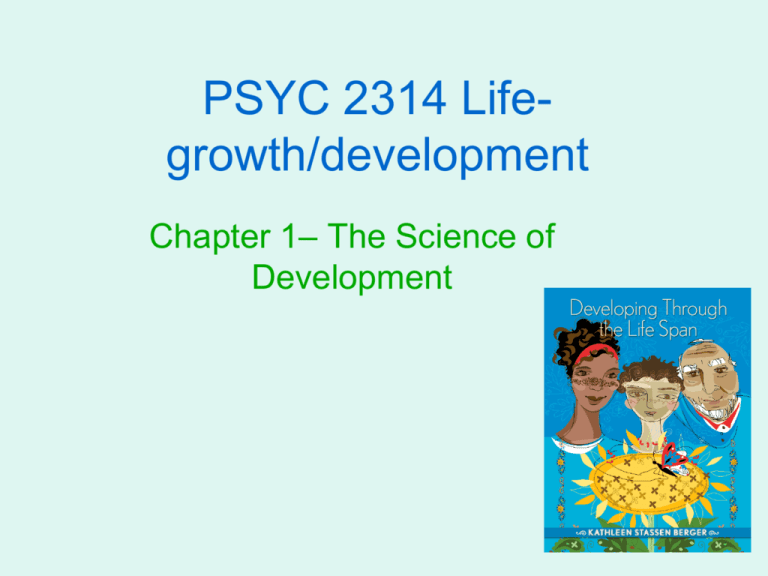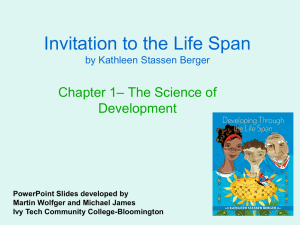The science of human development…
advertisement

PSYC 2314 Lifegrowth/development Chapter 1– The Science of Development Defining Development The science of human development… seeks to understand how and why people—all kinds of people, everywhere, of every age—change over time. Understanding How and Why Five basic steps of the scientific method: • On the basis of theory, prior research, or a personal observation, pose a question. • Develop a hypothesis, a specific prediction, that can be tested. • Test the hypothesis. Design and conduct research to gather empirical evidence (data). • Draw conclusions. Use the evidence to support or refute the hypothesis. • Report the results. Share the data and conclusions, as well as alternative explanation. The Nature-Nurture Debate: HOW do they interact? • Nature refers to the influence of genes which we inherit. • Nurture refers to environmental influences, such as: – – – – – health and diet of the embryo’s mother family school community society Critical and Sensitive Periods • A critical period is a time when certain things must occur for normal development (limb development). • A sensitive period is when a particular development occurs most easily (language). 3 parts of definition • how and why = scientific method • all kinds of people = different, not inferior • change over time = all transformations AND consistencies, from conception until death The Life-Span Perspective Development is multidirectional • Over time, human characteristics change in every direction (height & weight – many things can affect these). • Several major theorists describe stages of development: Freud, Erickson, Piaget. • Others view development as a continuous process. The Life-Span Perspective Development Is Multicontextual: 2 main contexts • HISTORICAL • SOCIOECONOMIC The Life-Span Perspective Development Is Multicontextual • HISTORICAL CONTEXT- All persons born within a few years of one another are said to be a cohort, a group defined by the shared age of its members. The Life-Span Perspective Socioeconomic Context socioeconomic status (SES) A person’s position in society as determined by income, wealth, occupation, education, and place of residence. The Life-Span Perspective Development Is Multicultural • Culture - patterns of behavior that are passed from one generation to the next. • Vygotsky described the interaction between culture and education. • Ethnic group - People whose ancestors were born in the same region and who often share a language, culture, and religion (but may not share culture); race is a social (not biological) construction The Life-Span Perspective Development Is Multidisciplinary • Genetics and neuroscience are two of the newer disciplines in lifespan research. • Every trait—psychological as well as physical—is influenced by genes. The Life-Span Perspective Development Is Plastic • Human traits can be molded (as plastic can be), yet people maintain a certain durability of identity (as plastic does). • Mirror neurons- Cells in an observer’s brain that respond to an action performed by someone else in the same way they would if the observer had actually performed that action. Theories of Human Development A developmental theory is a systematic statement of principles and generalizations that provides a framework for understanding how and why people change as they grow older. Theories of Human Development Psychoanalytic Theory • A theory of human development that holds that irrational, unconscious drives and motives, often originating in childhood, underlie human behavior. • Psychoanalytic theory originated with Sigmund Freud (1856– 1939) – each stage includes potential conflicts • how a person experiences and resolves conflicts determines personality and patterns of behavior Theories of Human Development Erickson’s Stages • Erik Erikson (1902–1994) • Described eight developmental stages, each characterized by a challenging developmental crisis. • His first five stages build on Freud’s theory; but, he also described three adult stages. Theories of Human Development Erickson’s Stages – – – – – – – – trust vs. mistrust autonomy vs. shame initiative vs. guilt industry vs. inferiority identity vs. role diffusion intimacy vs. isolation generativity vs. stagnation integrity vs. despair Theories of Human Development Theories of Human Development Behaviorism • A theory of human development that studies observable behavior. Behaviorism is also called learning theory, because it describes the laws and processes by which behavior is learned. • Conditioning- According to behaviorism, the processes by which responses become linked to particular stimuli and learning takes place. Theories of Human Development Classical conditioning - Ivan Pavlov (1849-1936) • (also called respondent conditioning), a process in which a person or animal learns to associate a neutral stimulus with a meaningful stimulus, gradually reacting to the neutral stimulus with the same response as to the meaningful one. Theories of Human Development Operant conditioning - B.F. Skinner (1904–1990) • (also called instrumental conditioning) a learning process in which a particular action is followed either by something desired (which makes the person or animal more likely to repeat the action) or by something unwanted (which makes the action less likely to be repeated). Theories of Human Development Theories of Human Development Social Learning Theory - Albert Bandura (b. 1925) • An extension of behaviorism that emphasizes the influence that other people have over a person’s behavior. • Modeling- people learn by observing other people and then copying them. • Self-efficacy- (how effective people think they are when it comes to changing themselves or altering their social context. Theories of Human Development Cognitive Theory • Thoughts and expectations profoundly affect action. • Focuses on changes in how people think over time. • Jean Piaget (1896–1980) Theories of Human Development Theories of Human Development • Assimilation, in which new experiences are interpreted to fit into, or assimilate with, old ideas • Accommodation, in which old ideas are restructured to include, or accommodate, new experiences Theories of Human Development Systems Theory • Change in one part of a person, family, or society affects every aspect of development Ecological systems approach- Urie Bronfenbrenner (1917–2005) • The person should be considered in all the contexts and interactions that constitute a life. Theories of Human Development Five Components of Bronfenbrenner’s System • microsystems (elements of the person’s immediate surroundings, such as family and peer group) • exosystems (local institutions such as school and church) • macrosystems (the larger social setting, including cultural values, economic policies, and political processes) Theories of Human Development • chronosystem (literally, “time system”), which affects the other three systems • mesosystem, consisting of the connections among the other systems What Theories Can Contribute • Psychoanalytic theory has made us aware of importance of early childhood experiences • Behaviorism has shown effect of immediate environment on learning • Cognitive theory helps us understand how intellectual process and thinking affect actions Using the Scientific Method Scientific Observation • requires the researcher to record behavior systematically and objectively. • May be done in a naturalistic setting such as a home, school, or other public place. • May be done in a laboratory. Using the Scientific Method The Experiment establishes causal relationships among variables. • independent variable- the variable that is introduced to see what effect it has on the dependent variable. • dependent variable- the variable that may change as a result of whatever new condition or situation the experimenter adds. Using the Scientific Method • experimental group- gets a particular treatment (the independent variable). • comparison group (also called a control group), which does not get the treatment. How to Conduct an Experiment Using the Scientific Method Using the Scientific Method The Survey • Information is collected from a large number of people by interview, questionnaire, or some other means. • Acquiring valid survey data is not easy. • Some people lie, some change their minds. • Survey answers are influenced by the wording and the sequence of the questions. Studying Changes over Time • Developmental research must be able to deal with changes that continue over time – research design allows researchers to include time, or age, as a factor – three basic designs: • cross-sectional, longitudinal, cross-sequential Studying Development over the Life Span Cross-sectional Research • Groups of people of one age are compared with people of another age. Longitudinal Research • Collecting data repeatedly on the same individuals as they age. Cross-sequential Research • Study several groups of people of different ages (a cross-sectional approach) and follow them over the years (a longitudinal approach). Cross-sectional, Longitudinal, and CrossSequential Research: Which is Best? Cross-sectional, Longitudinal, and CrossSequential Research: Which is Best?, cont. Cautions from Science Correlation and Causation • A correlation exists between two variables if one variable is more (or less) likely to occur when the other does. • A correlation is positive if both variables tend to increase together or decrease together. • A correlation is negative if one variable tends to increase while the other decreases. • A correlation is zero if no connection is evident. • Correlation does not imply causation Ethics Each academic discipline and professional society involved in the study of human development has a code of ethics. • Researchers must ensure that participation is voluntary, confidential, and harmless. • Subjects (participants in research) must give informed consent- they must understand the research procedures and any risks involved.




